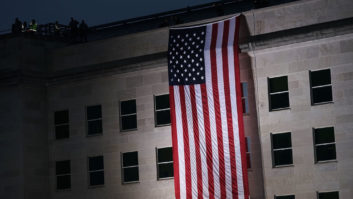New Group Aims to Upgrade Disaster Warning System
WASHINGTON Should the Emergency Alert System have been activated in New York and Washington on Sept. 11? Should EAS be activated in case of another domestic attack?
Debate about these issues among emergency preparedness and broadcast experts has been sharp. As the issue has reached a higher level of national interest, a group has been formed to address these questions.
The group is called the Partnership for Public Warning. The public-private partnership comprises leaders from emergency management, government, broadcast engineering and private business.
Members are working to improve the collection and delivery of emergency warning information. They have appointed a board of trustees and hope to open a Washington headquarters and name a permanent executive director before the end of the year.
The organization was formed after the Sept. 11 terrorist attacks following debate over whether an activation of the Emergency Alert System should have taken place in New York and Washington.
Local officials elected not to run emergency warnings the day of the attacks citing lack of any forewarning. The nation’s Primary Entry Point stations were readied if President Bush had wanted to address the nation through an Emergency Action Notification message.
Some within the emergency alert community argue a warning could have helped those in the north World Trade Center tower, which collapsed approximately 39 minutes after the first tower fell.
The FCC also asked stations to suspend EAS tests temporarily to help avoid public panic.
Defense contractor Mitre Corp. hosted an organizational meeting last November. The Bedford, Mass., company gave $500,000 as start-up money. Mitre is a not-for-profit firm that provides information technology support to the government.
PPW officials say the group’s goal is to open a dialogue among civil defense planners and private parties to discuss ways to make warnings more efficient and to figure out the best way to get information to specific populations in the event of further terrorist attacks in the United States.
The initiative’s leaders also say certain facets of EAS need improvement and that any new warning system should incorporate new technologies available to deliver disaster information. Those include personal communication devices such as cell phones, pagers and e-mail alerts. They say broadcasters will continue to play a key role in any new system.
“We need a new warning system that will reach more people. What we have now is quite ineffective,” said Peter Ward, chair of the board of trustees for Partnership for Public Warning.
He is former chairman of the Working Group on Natural Disaster Information Systems under the National Science and Technology Council and former geophysicist with the U.S. Geological Survey.
“EAS is based on 1950s technology. New technology is not being implemented because there is no clear direction and standards. There is no clear definition of what the role of government should have vs. private industry. We need a clear vision.”
Ward said entrepreneurs developing “wonderful new warning systems” are finding they cannot get funding for their research and development. He hopes the group eventually will be able to give financial assistance to those in the product development process.
Funding for the partnership will come from public and private sources, Ward said. The organization is talking with officials from the Federal Emergency Management Agency and other governmental agencies about receiving funding. He said it hopes to raise $2 million from government and industry sources by the end of the year to pay for travel and conferences.
“We want a 50/50 split on funding from public and private (sources). We will eventually sell memberships to raise funds and also apply for government grants. Membership will consist of private businesses and organizations from government and academia,” he said.
FEMA official Tim Putprush said the agency is looking for ways to use the new initiative.
“We’re actively engaged with PPW. (FEMA) has identified things that can be worked on. I think they can help develop a comprehensive warning plan,” Putprush said.
Richard Rudman, chairman of the EAS National Advisory Committee and the Los Angeles County local emergency committee, said the events of Sept. 11 have brought the issue of emergency public information to a higher level of national priority. Rudman also serves on the PPW board of directors.
“It’s clear that we have to go beyond EAS. We’re trying to create emergency lanes on as many different information highways as we can and to have them all connected with the same warning protocol. We have to extend warnings into areas where they haven’t gone before,” Rudman said.
He hopes to have groups sharing information to develop a common warning language that ultimately can be placed in the public domain without being clouded by the fear of charges of patent infringement and other encumbrances, similar to the current Quad Dimension Inc. dispute over the patent for EAS protocol (see sidebar).
“We know we have a lot of people studying warnings and developing great new technology, but they’re not talking to each other. The PPW hopes to bring all of those groups together,” Rudman said.
The PPW hopes to work with the consumer electronics and wireless communication industries to form a consensus between emergency officials and equipment manufacturers, Ward said.
“Our vision for the future is that every piece of consumers electronics that people buy should have warning capability built in to provide warning information to an individual that they have a personal interest in,” Ward said.
That could include using technology such as an “e-chip” that could activate warnings through personal communication devices, computers and set-top boxes, not just radio or television.
Such a device could monitor warning information constantly and activate when the appropriate warning was issued, Ward said.
“We believe a warning system could be integrated into society and be omni-present in many different areas. We have to define where the points of interoperability need to be to be able to put standards in place,” Ward said.
The cost incurred by consumers for new technology could be an issue, Ward said.
“In large quantities, e-chip technology may only add $1 to the cost of a radio. Eventually it will become much cheaper. Certainly in most cases it’s under $10 right now.”
Ward said it could take as many as 10 years to have consumer electronics manufacturers producing the necessary equipment to allow for time for further testing and development.
The chips of the future could even give people warnings in a specific language, Ward said. “This is not science fiction. This is technology that is already accessible at the moment,” he said.
Jeffrey Joseph, vice president of communications for the Consumer Electronics Association, said the trade group would be willing to listen proposals aimed at strengthening the current warning system.
“If it’s for the benefit of the country, we would be happy to discuss ideas. A lot would depend one whether there is demand for that type of technology in the marketplace,” Joseph said.
The wireless communications industry has generally opposed any kind of federal mandate or requirement to develop such technology, said Travis Larson, spokesman for the Cellular Telecommunications and Internet Association.
Larson said there are services available now, such as weather.com, that offer weather alerts via the Internet and Personal Digital Assistants. “We would certainly examine the situation and see if there is a need,” Larson said.
Ward said the PPW’s intent is to avoid any kind of government mandate requiring compliance by broadcasters and equipment manufacturers with any new warning system.
“By involving industry in developing standards and approaches, we aim to avoid any government order. We hope to create an environment where business can see opportunities and develop them,” Ward said.
Art Botterell, ex-broadcaster and former member of the California Office of Emergency Services, said EAS is a patchwork of technologies and procedures with no means of coordination.
“The history of warning systems in the U.S. is filled with shoot-from-the-hip local solutions and bits of sound-bite engineering that offer an illusion of security but fails to deliver,” Botterell said. “All of the stakeholders from state and local emergency officials to the media and equipment manufacturers must come together to create a coherent national strategy.”
Botterell serves on the PPW board of directors.
Some in the broadcast engineering community disagree with new efforts to make any new warning system cutting-edge.
“My advice would be to keep things simple. Simple and reliability go together,” said Burt Weiner, former chief engineer for several Los Angeles radio stations, now a technical consultant. “The more sophisticated things are, the more they are prone to failure.”
In addition to finding office space in the nation’s capitol and naming a permanent executive director, Ward said the new partnership’s first steps would be to formulate a long-term national strategic plan and develop a migration plan.
“We won’t be able to draft this plan overnight certainly. We want to get the best people we can on board to get their input and thoughts. Then maybe have a plan in six to eight months,” he said.
He said the group’s new executive director will be someone with experience in warning systems, skill in leading an association and knowledge of the “players” involved.
Information on the Partnership for Public Warning is available online at www.partnershipforpublicwarning.org.











